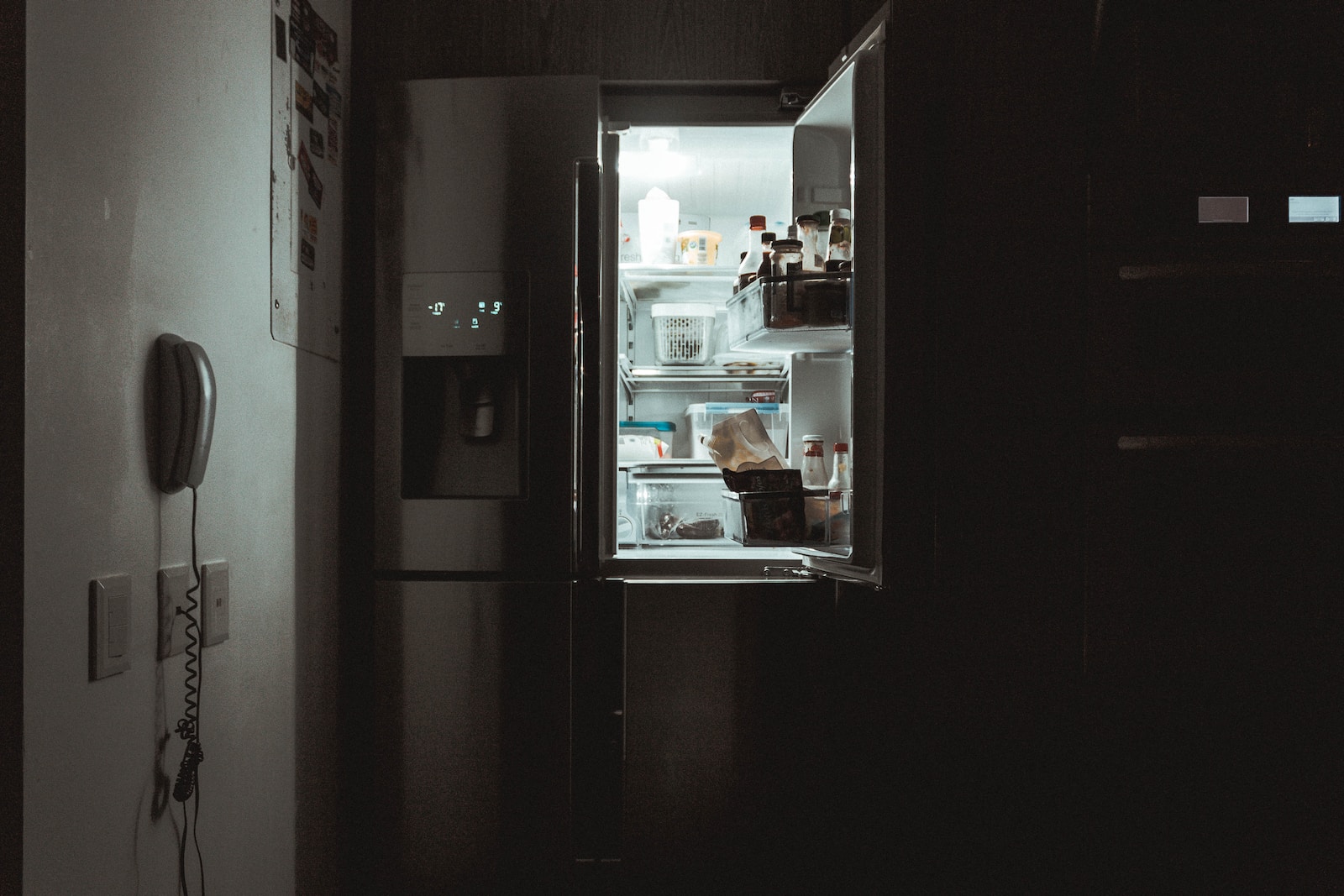Welcome to the perplexing world of a freezer working, but a fridge failing to keep your food cool. Picture this: you swing open the refrigerator door, searching for that refreshing cold drink or a leftover slice of pizza, only to be met with lukewarm disappointment.
It’s as if the fridge has decided it no longer wants to fulfill its duty of preserving your perishables at an optimal temperature. But fear not, for in this article, we shall delve into the depths of this conundrum and unravel its mysteries!
Brief Explanation: Freezer Working, but Fridge Not Cooling Properly
So, what exactly does it mean when your freezer is chilling like an arctic beast while the fridge seems as warm as a summer’s breeze? This baffling scenario typically arises due to an imbalance in temperature distribution within your refrigerator.
While the freezer compartment is designed to reach sub-zero temperatures and maintain them efficiently, the fridge section relies on proper airflow from that frosty domain to cool itself adequately. When the balance between these two sections falters, you end up with a freezer doing its job splendidly while its counterpart struggles to maintain coolness.
This imbalance can occur due to various reasons which we will explore shortly. But before we dive into solutions and troubleshooting tips, let us take a moment to appreciate just how crucial a functioning refrigerator is in our daily lives.
The Importance of a Functioning Refrigerator in Daily Life
In our fast-paced modern existence, where every moment counts and schedules are jam-packed with responsibilities and commitments, having a reliable refrigerator becomes paramount. It acts as our culinary sanctuary amidst the chaos of everyday life—an appliance that safeguards our edible treasures from succumbing prematurely to bacteria’s clutches or becoming unpleasantly warm.
A properly working fridge ensures that groceries stay fresh, leftovers remain edible for another scrumptious meal, and your favorite beverages are chilled to perfection. It is the cornerstone of a well-stocked kitchen, preserving nutrients and flavors while granting us the convenience of having food readily available without constant trips to the grocery store.
Whether it’s a refreshing glass of lemonade on a sweltering summer day or the delightful leftovers from last night’s dinner, a functioning refrigerator enhances our lives by providing nourishment, comfort, and peace of mind. That is precisely why when we encounter the enigma of a freezer functioning flawlessly but a fridge failing to keep things cool, it becomes an urgent matter that requires our attention and know-how.
Understanding the Basics
Overview of how a refrigerator works
Ever wondered how your refrigerator keeps your food cool and fresh? Well, let’s delve into the fascinating world of refrigeration!
At its core, a refrigerator operates based on the principle of heat transfer. It uses a refrigeration cycle that involves compressing and expanding a refrigerant gas to remove heat from inside the fridge.
The process starts with the compressor, which squeezes the refrigerant gas, increasing its pressure and temperature. This hot gas then flows through a set of coils called condenser coils located at the back or bottom of the fridge.
As it loses heat to the surroundings, it cools down and transforms into a liquid state. Next, this liquid refrigerant enters an expansion valve (also known as an evaporator), where it rapidly expands.
This causes it to absorb heat from inside the fridge and turns back into a gas. As it absorbs heat, it cools down the air in contact with the evaporator coils.
The cold air produced by this process is then circulated throughout different compartments within your refrigerator via fans or natural convection. By removing heat from these compartments, your fridge creates low temperatures to keep your food fresh.
Different compartments and their functions
Now that we understand how refrigeration works in general let’s take a closer look at different compartments within your trusty refrigerator and what their specific functions are. Firstly, we have the freezer compartment which is responsible for freezing foods below 0 degrees Celsius (32 degrees Fahrenheit). It typically has its own independent temperature control to maintain sub-zero temperatures required for long-term food preservation.
Then comes our beloved fridge compartment which keeps our perishable foods fresh without freezing them solid. The ideal temperature range for this compartment is usually around 1-5 degrees Celsius (34-41 degrees Fahrenheit), providing optimal conditions for storing items like fruits, vegetables, and dairy products.
Apart from the primary freezer and fridge compartments, you might also find additional storage spaces such as vegetable crisper drawers, deli or dairy compartments, and door shelves. These specialized areas are designed to provide specific temperature and humidity conditions to keep different types of foods at their best.
Understanding the purpose of each compartment is crucial in troubleshooting issues with your refrigerator. So next time you open up your fridge door, spare a thought for the remarkable mechanism that keeps your food fresh and ready to devour!
Common Causes for Fridge Not Cooling
When your freezer is working fine but the fridge fails to keep things cool, there can be several common culprits behind this frustrating issue. Let’s explore them in detail:
Blocked Air Vents: The Culprit Behind Poor Food Placement or Frost Buildup
One of the main reasons for inadequate cooling in the refrigerator compartment is blocked air vents. These vents play a crucial role in distributing cold air throughout the unit, ensuring proper temperature regulation.
Improper food placement can inadvertently obstruct these vents, preventing the flow of cold air into the fridge. To avoid this issue, it is important to arrange your food items strategically, leaving enough space around the air vents for smooth airflow.
Similarly, excessive frost buildup on these vents can also hinder proper circulation. If you notice a layer of frost on the vent openings or inside the fridge, it’s essential to defrost your freezer promptly and remove any excess ice to restore optimal airflow.
Faulty Temperature Control Mechanism or Thermostat: The Trouble with Regulation
In some cases, a malfunctioning temperature control mechanism or thermostat could be responsible for your refrigerator’s cooling woes. These components are responsible for detecting and regulating the desired temperature inside your appliance. If you suspect an issue with the thermostat, try adjusting it manually and monitor if that makes any difference in cooling performance over time.
If not, it may warrant replacing these components altogether. Consult your refrigerator’s user manual or seek professional assistance to determine how you can replace faulty parts effectively.
Inadequate Airflow: The Dirty Coils and Clogged Fan Conundrum
An often overlooked but critical factor in maintaining proper cooling is ensuring adequate airflow within your fridge. Dirty condenser coils at the back or bottom of the unit can impede heat dissipation, causing your refrigerator to struggle in maintaining cool temperatures.
Regularly cleaning these coils using a vacuum or a soft brush can effectively remove accumulated dust and debris, allowing for smooth airflow and optimal cooling performance. Similarly, a clogged fan can disrupt ventilation, leading to insufficient cooling.
Ensuring that the fan is clean and free from obstructions is essential for optimal airflow and temperature regulation within the fridge compartment. By understanding these common causes of poor cooling in the refrigerator compartment, you can take necessary steps to troubleshoot and resolve the issue.
Remember to check for blocked air vents due to improper food placement or excessive frost buildup, examine the functioning of temperature control mechanisms or thermostats, and ensure adequate airflow by cleaning condenser coils and checking for clogged fans. By addressing these issues proactively, you will be well on your way towards restoring your fridge’s cooling efficiency.
Troubleshooting Steps to Fix the Issue
Checking and adjusting temperature settings
When faced with a refrigerator problem, the first step is to assess the temperature settings. A common mistake is setting the temperatures too high or low, which can affect proper cooling.
The optimal temperature range for your fridge compartment is typically between 35°F and 38°F (1.7°C and 3.3°C), while the freezer compartment should be set between 0°F and 5°F (-17.8°C and -15°C). However, these ranges may vary slightly depending on your specific refrigerator model.
Adjusting temperature settings is usually straightforward. Look for a control panel or dial inside your fridge, often located near the top or on one of the side walls.
On some models, you might find separate controls for each compartment, while others have a single control that regulates both sections simultaneously. Refer to your refrigerator’s manual if needed, as instructions can vary across brands.
Ensuring proper airflow and ventilation
Proper airflow is essential for maintaining optimal cooling in both compartments of your refrigerator. Start by inspecting the condenser coils located at either the back or bottom of your appliance.
Over time, these coils can accumulate dust, dirt, or pet hair that restricts airflow and reduces cooling efficiency. Cleaning them regularly with a soft brush or vacuum cleaner will help restore their effectiveness.
Additionally, make sure there are no obstructions around ventilation areas within your fridge’s interior or exterior structure. Check for items blocking air vents inside the compartments – rearrange food items if necessary – as blocked vents disrupt airflow circulation within the unit.
Defrosting excessive frost buildup in freezer compartment
Excessive frost buildup in the freezer can hinder proper cooling throughout your refrigerator system. If you notice a thick layer of frost on the walls or food items, it’s time to defrost.
Manual defrosting methods involve emptying the freezer, unplugging the appliance, and allowing the frost to melt naturally. Place towels or absorbent materials around the freezer area to collect water drips.
However, some modern refrigerators come equipped with an automatic defrost feature, which eliminates the need for manual intervention. If your model has this feature, consult your manual for specific instructions on activating and utilizing it effectively.
Advanced Issues and Solutions (for rare cases)
Even after following the troubleshooting steps mentioned above, there may be rare situations where more complex issues arise. In such cases, it is advisable to seek professional assistance from a certified technician who can diagnose and fix advanced problems. These issues could include faulty compressor motors, malfunctioning fans or sensors, or refrigerant leaks – all of which require specialized knowledge and tools for repair.
Remember that attempting repairs beyond your expertise can potentially worsen the situation or void any warranty on your refrigerator. By relying on a trained professional with experience in refrigerator repairs, you ensure a safer and more efficient resolution to any advanced issues that may arise.
Conclusion
When faced with a fridge that’s not cooling properly while the freezer continues to function normally, troubleshooting is essential before considering replacement options. By checking and adjusting temperature settings within their recommended ranges for both compartments and ensuring proper airflow through regular cleaning of condenser coils and clearing obstructions near ventilation areas, you increase your chances of resolving common cooling issues. In rare cases where advanced problems persist despite troubleshooting efforts, calling upon professional help becomes crucial.
Remember that refrigerators are complex appliances with intricate systems that require specialized knowledge for repair work beyond basic maintenance tasks. Stay optimistic as you navigate these challenges – a functional fridge is within reach!


